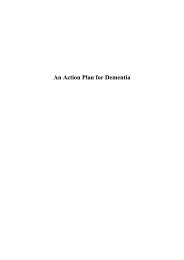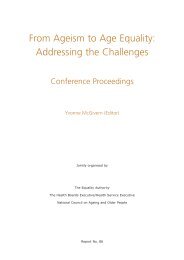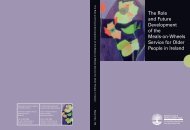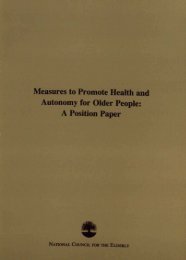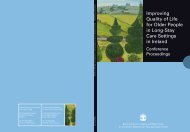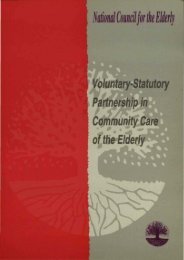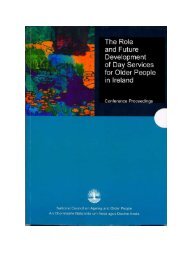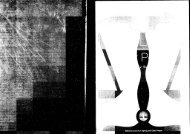Improving Quality of Life for Older People in Long-Stay Care ...
Improving Quality of Life for Older People in Long-Stay Care ...
Improving Quality of Life for Older People in Long-Stay Care ...
- No tags were found...
Create successful ePaper yourself
Turn your PDF publications into a flip-book with our unique Google optimized e-Paper software.
Staff respondents also highlighted their educational needs; they suggested thattra<strong>in</strong><strong>in</strong>g was important <strong>in</strong> order to give <strong>in</strong><strong>for</strong>med care. Some staff respondentshighlighted the difficulties <strong>of</strong> participat<strong>in</strong>g <strong>in</strong> educational opportunities; low staff<strong>in</strong>glevels and lack <strong>of</strong> availability were cited as the major issues. Nurs<strong>in</strong>g staff identifieda need <strong>for</strong> cl<strong>in</strong>ical updat<strong>in</strong>g and <strong>for</strong> courses which focused on the needs <strong>of</strong> olderpeople. One staff respondent <strong>in</strong> a senior managerial position described how shehad set up an educational network with other facilities <strong>in</strong> order to maximiseeducational opportunities <strong>for</strong> staff. <strong>Care</strong> attendants also discussed their educationalneeds. In some facilities care attendants who had undertaken the health careassistant course highlighted the difference this had made to their capacity to care<strong>for</strong> residents. They were concerned, however, that they had not been able to takeup a new role on return from the course. In the focus groups, participants alsoraised the issue <strong>of</strong> the health care assistant tra<strong>in</strong><strong>in</strong>g course. They were extremelypositive about this course and felt that it had really made a difference to client care.Many, however, had also experienced difficulties <strong>in</strong> implement<strong>in</strong>g the new rolewith<strong>in</strong> their facilities.8.5 Physical Environment161The issue <strong>of</strong> physical environment was raised by a number <strong>of</strong> respondents (Table8.3). Staff and resident respondents and relatives highlighted the importance <strong>of</strong>homely environments which were structured to give residents a choice <strong>of</strong> their ownroom if desired. For some resident respondents, the lack <strong>of</strong> a private room was areal problem, particularly <strong>in</strong> public facilities. Communal facilities were much morea feature <strong>of</strong> public facilities than private ones. Residents found life <strong>in</strong> a communalward difficult and highlighted issues <strong>of</strong> privacy and the lack <strong>of</strong> choice <strong>in</strong> listen<strong>in</strong>gto the television or radio. Relatives also shared this concern. It was evident fromresident <strong>in</strong>terviews that the quality <strong>of</strong> the physical environment made a differenceto resident quality <strong>of</strong> life. Poor physical facilities meant that some residents, ma<strong>in</strong>ly<strong>in</strong> public facilities, spent substantial time each day by their bed.It was also evident from observation with<strong>in</strong> the study sites that liv<strong>in</strong>g <strong>in</strong> a communalward impacted on the capacity <strong>of</strong> a resident to exercise choice about the time theygot up <strong>in</strong> the morn<strong>in</strong>g. The general noise <strong>of</strong> others gett<strong>in</strong>g up was likely to disturball residents <strong>in</strong> a ward which made later wak<strong>in</strong>g impossible. An additional problemhighlighted by a number <strong>of</strong> resident respondents with<strong>in</strong> a few public care study




